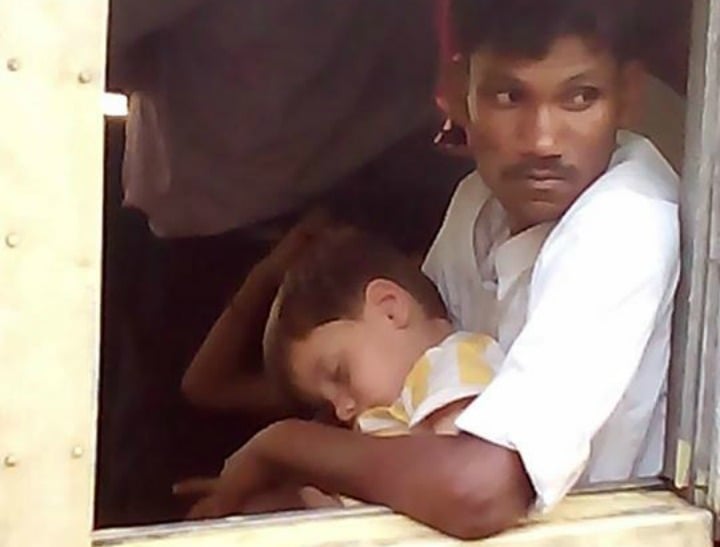
Playing online detective can be a dangerous game.
You may have seen this photo circulating on social media in recent days.
According to a man in New Delhi, this stranger on a train is a human trafficker.
This assumption is based on the fact he is an Indian man holding a white child. He also assumes that the child is sleeping because it has been drugged. He asks punters to share the post and get this (maybe) stolen boy back to his parents (if he is not in fact already asleep on his father’s lap).
It is circulated. And widely.
Posted on Facebook only a couple of days ago, the picture has already been shared more than 400,000 times.
Now, according to online amateur sleuths, the boy closely resembles William Tyrell — the three-year-old boy who went missing from New South Wales’ mid-north coast last September.
No doubt NSW – who have a complex operation to find William in place – have since been inundated with phone calls.
While it’s heartening that people care and want to help find William Tryell, it’s concerning that, should the small white boy actually just be travelling with his relative or carer, the reputation of the man on the train has been internationally smeared.
For all we know, he could be a loving father, now falsely labelled a child trafficker.
It wouldn’t be the first time online vigilantes have got it wrong.
Related: Man takes a selfie. Next minute, he is the victim of an online hate campaign.

Top Comments
This is absurd. The fact of the matter is the boy is still missing and if anything suspicious arises the public is urged to inform authorities. If authorities had all they needed to find the boy they would not circulate his photo for possible sightings.
As for innocent people being badgered due to online speculation and concern, do you mean you? As the man who originally posted the photo clearly states that the man holding the boy "could" be part of some human traficing organisation because the situation seemed odd to him.
If there is even a small chance that this boy could be William, it should be investigated.
He confirms in no way that the man holding the boy is a kidnapper and since your post is about assuming you should be so hypocritical as to say " according to this man, the man in the photo is a human traficer.
This boy's parents are going through hell, maybe have some respect when referring to the boy. A child is never an it.
Thank you for this story... when I saw this picture posted on NCMEC, I posted and asked them to delete it. I was then bombarded by posts from people telling me what a horrible person I was. I continued to defend my position on it for 2 days until NCMEC finally did pull the picture. I occasionally look for updates on this picture to see if anyone figured out who this guy was, but so far the only thing I have found is this blog- even though I felt like I was the only person that didn't feel this picture should be shared, seeing your post, I know I am not the only person that thinks it's wrong to post something about someone without any facts. This guy could have been this kid's Father, Uncle anything... a lot of the comments were that this guy could go to the police and clear it up- even if he goes to the Police and clears it up, doesn't mean it's going to go public and doesn't make this picture disappear, it would continue to be circulated, and he would forever be known as a trafficker because he took a ride on a train with possibly his son cradled in his arm. It could prevent him from getting a job, a place live, etc...people just don't care that they ruin other people's lives at all, it seemed to be ok, since they didn't know him. A lot of comments were you could save a child by sharing this, the child is more important then the man's reputation- what if this kid is his son, and this child they are trying to "save" now ends up homeless and hungry with his father, because now his father is unable to find a job or home because they were sharing a picture, that wasn't true, trying to "save" the child. I was really disturbed by it, it really bothered me. If this is acceptable, this could happen to anybody.